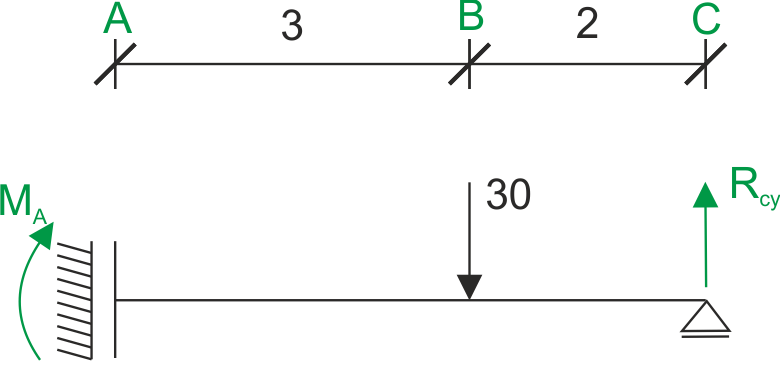Edupanda » Strength of Materials » Castigliano's theorem - calculating deflections and rotations in beams
Castigliano's theorem
Calculating deflections and rotations in beams
In this text you will learn what Castigliano's theorem is and how it works. You will see the algorithm for solving problems with this method. You will find example solutions
\begin{aligned} U^M=\int_{0}^{l}{\frac{M_g^2}{2EI}}dx \end{aligned}
In the case of a sudden change in the cross-section of the rod or a system composed of several rods - we determine the elastic energy as the sum of the energy accumulated on the length \(l_i\) of the rod.
\begin{aligned} U^M=\sum \int_{0}^{l_i}{\frac{M_g^2}{2EI}}dx \end{aligned}
and after differentiation we get
\begin{aligned} \delta_i=\sum \frac{1}{EI} \int_{0}^{l_i} (M_g \cdot \frac{\partial M_g}{\partial P_i} dx) \end{aligned}
The above equation is of a general nature.


To be able to differentiate with respect to force, we need to assign it some notation, let's take P=30 [kN].

Therefore (this is very important) - in the task there IS already a force acting at the location and in the direction of the desired displacement (the 30 kN force is a concentrated vertical force - it corresponds to the desired vertical displacement).
Hence, we don't need to do anything extra, we calculate the task as it is given.
If we were looking for rotation angle at point B, then we would notice that there is NO force corresponding to the desired displacement at point B (the rotation angle corresponds to the concentrated moment).
If there is no concentrated moment applied where we need to calculate the rotation angle, we need to add a fictitious moment \(M^*=0\), calculate the reactions considering this moment, perform the differentiation with respect to \(M^* \) . In the final step, we substitute \(M^*=0\).
The function can also be written from the right side, one interval from left A-B, and the other from right C-B.
We encourage you to check different variants for practice, calculate the desired displacement and compare the results.
Moment functions in the A-B range => x∈<0;2)m and BC range => x∈<3;5)m
\begin{aligned} &M_{g1}^{AB}=M_A=2P^*\\ &M_{g2}^{BC}=2P^*-P^*\cdot (x-3)\\ \end{aligned} Derivatives of moment functions with respect to \(P^*\) in each range, i.e. \(\frac{\partial M g_i(x)}{\partial P^*}\)
\begin{aligned} &\frac{\partial M_{g1}}{\partial P^*}=2 \\ &\frac{\partial M_{g2}}{\partial P^*}=2-(x-3)=5-x \\ \end{aligned} We calculate the deflection at point B.
According to the formula presented earlier:
\begin{aligned} \delta_i=\sum \frac{1}{EI} \int_{0}^{l_i} (M_{gi} \cdot \frac{\partial M_{gi}}{\partial P^*} )dx \end{aligned}
where:
\(\delta_i\) - the desired displacement at point B \(\Rightarrow \Delta_{y_B}\)
So, finally:
\begin{align} & \Delta_{y_B}=\frac{1}{EI}\left[ \int_{0}^{3} (M_{g1} \cdot \frac{\partial M_{g1}}{\partial P^*} )dx + \int_{3}^{5} (M_{g2} \cdot \frac{\partial M_{g2}}{\partial P^*} )dx \right] \\ & \Delta_{y_B}=\frac{1}{EI}\left[ \int_{0}^{3} (2\cdot P^* \cdot 2 )dx + \int_{3}^{5} (2P^*-P^*\cdot (x-3)) \cdot (5-x)dx \right] \\ \end{align} In Castigliano's method tasks, at this stage we remind ourselves of the value of the force after which we performed the differentiation. In this case, \(P^*=30\ [kN]\) and we substitute that value. \(\begin{aligned} & \Delta_{\mathrm{yB}}=\frac{1}{\mathrm{EI}}\left[\int_0^3 2 \cdot 30 \cdot 2 \mathrm{dx}+\int_3^5[2 \cdot 30-30 \cdot(\mathrm{x}-3)](5-\mathrm{x}) \mathrm{dx}\right] \\ & \Delta_{\mathrm{yB}}=\frac{1}{\mathrm{EI}}\left[\int_0^3 120 \mathrm{dx}+\int_3^5\left(30 \cdot \mathrm{x}^2-300 \cdot \mathrm{x}+750\right) \mathrm{dx}\right] \\ & \Delta_{\mathrm{yB}}=\frac{1}{\mathrm{EI}}\left[120 \cdot 3+30 \cdot \frac{\left(5^3-3^3\right)}{3}-300 \cdot \frac{\left(5^2-3^2\right)}{2}+750(5-3)\right]=\frac{440}{\mathrm{EI}} \end{aligned}\)

We notice that there is NO force corresponding to the desired displacement at point B (the rotation angle corresponds to the concentrated moment).
If there is no concentrated moment applied where we need to calculate the rotation angle, we need to add a fictitious moment \(M^*=0\), calculate the reactions considering this moment, perform the differentiation with respect to \(M^* \) . In the final step, we substitute \(M^*=0\).
\begin{aligned} &M_{g1}^{AB}=M_A=60-M^*\\ &M_{g2}^{CB}=R_{Cy}\cdot x=30\cdot x\\ \end{aligned} Derivatives of the moment function with respect to \(M^*\) in each interval, i.e. \(\frac{\partial M g_i(x)}{\partial M^*}\)
\begin{aligned} &\frac{\partial M_{g1}}{\partial M^*}=-1 \\ &\frac{\partial M_{g2}}{\partial M^*}=0 \\ \end{aligned} We calculate the rotation angle at point B.
\begin{align} & \varphi_{B}=\frac{1}{EI}\left[ \int_{0}^{3} (M_{g1} \cdot \frac{\partial M_{g1}}{\partial M^*} )dx + \int_{0}^{2} (M_{g2} \cdot \frac{\partial M_{g2}}{\partial M^*} )dx \right] \\ & \varphi_{B}=\frac{1}{EI}\left[ \int_{0}^{3} (60-M^*) \cdot (-1) )dx + \int_{0}^{2} (30\cdot x \cdot 0)dx \right] \\ \end{align} In Castigliano's method problems, we always remind ourselves at this stage what is the value of the force after which we differentiated. In this case, \(M^*=0 \) and we substitute this value. \(\begin{aligned} & \varphi_{B}=\frac{1}{EI}\left[ \int_{0}^{3} (60-0) \cdot (-1) )dx + \int_{0}^{2} (0)dx \right] \\ & \varphi_{B}=\frac{1}{EI}\left[ \int_{0}^{3} (-60) dx \right] = \frac{1}{EI}\left[ -60\cdot 3 \right] =\frac{-180}{EI} \\ \end{aligned}\)
↓ link to the database of tasks with solutions ↓
Castigliano's method
The value of the accumulated elastic energy in a bent rod (due to the bending moment alone).\begin{aligned} U^M=\int_{0}^{l}{\frac{M_g^2}{2EI}}dx \end{aligned}
In the case of a sudden change in the cross-section of the rod or a system composed of several rods - we determine the elastic energy as the sum of the energy accumulated on the length \(l_i\) of the rod.
\begin{aligned} U^M=\sum \int_{0}^{l_i}{\frac{M_g^2}{2EI}}dx \end{aligned}
and after differentiation we get
\begin{aligned} \delta_i=\sum \frac{1}{EI} \int_{0}^{l_i} (M_g \cdot \frac{\partial M_g}{\partial P_i} dx) \end{aligned}
The above equation is of a general nature.
- when determining deflection, we differentiate the bending moment with respect to the force acting at the location and in the direction of the desired displacement, and
- when determining rotation angle, we differentiate the bending moment with respect to the applied moment as described above.
Example 1
Content
Calculate the deflection and rotation angle at the point where the concentrated force is applied. Load on the beam is in [kN].

Solution

First, we calculate the deflection at point B.
When calculating deflection, we differentiate the function of the bending moment with respect to the force acting at the location and in the direction of the desired displacement.To be able to differentiate with respect to force, we need to assign it some notation, let's take P=30 [kN].

Therefore (this is very important) - in the task there IS already a force acting at the location and in the direction of the desired displacement (the 30 kN force is a concentrated vertical force - it corresponds to the desired vertical displacement).
Hence, we don't need to do anything extra, we calculate the task as it is given.
If we were looking for rotation angle at point B, then we would notice that there is NO force corresponding to the desired displacement at point B (the rotation angle corresponds to the concentrated moment).
If there is no concentrated moment applied where we need to calculate the rotation angle, we need to add a fictitious moment \(M^*=0\), calculate the reactions considering this moment, perform the differentiation with respect to \(M^* \) . In the final step, we substitute \(M^*=0\).
We calculate support reactions
\begin{align} & \sum{Y}=0\\ & R_{CY}=P^*\\ & \sum{M_C}=0\\ & M_{A}-P^*\cdot 2=0\\ & M_{A}=2P^* \\ \end{align} We write down the moment function in the AB range and BC range from the left side.The function can also be written from the right side, one interval from left A-B, and the other from right C-B.
We encourage you to check different variants for practice, calculate the desired displacement and compare the results.
Moment functions in the A-B range => x∈<0;2)m and BC range => x∈<3;5)m
\begin{aligned} &M_{g1}^{AB}=M_A=2P^*\\ &M_{g2}^{BC}=2P^*-P^*\cdot (x-3)\\ \end{aligned} Derivatives of moment functions with respect to \(P^*\) in each range, i.e. \(\frac{\partial M g_i(x)}{\partial P^*}\)
\begin{aligned} &\frac{\partial M_{g1}}{\partial P^*}=2 \\ &\frac{\partial M_{g2}}{\partial P^*}=2-(x-3)=5-x \\ \end{aligned} We calculate the deflection at point B.
According to the formula presented earlier:
\begin{aligned} \delta_i=\sum \frac{1}{EI} \int_{0}^{l_i} (M_{gi} \cdot \frac{\partial M_{gi}}{\partial P^*} )dx \end{aligned}
where:
\(\delta_i\) - the desired displacement at point B \(\Rightarrow \Delta_{y_B}\)
So, finally:
\begin{align} & \Delta_{y_B}=\frac{1}{EI}\left[ \int_{0}^{3} (M_{g1} \cdot \frac{\partial M_{g1}}{\partial P^*} )dx + \int_{3}^{5} (M_{g2} \cdot \frac{\partial M_{g2}}{\partial P^*} )dx \right] \\ & \Delta_{y_B}=\frac{1}{EI}\left[ \int_{0}^{3} (2\cdot P^* \cdot 2 )dx + \int_{3}^{5} (2P^*-P^*\cdot (x-3)) \cdot (5-x)dx \right] \\ \end{align} In Castigliano's method tasks, at this stage we remind ourselves of the value of the force after which we performed the differentiation. In this case, \(P^*=30\ [kN]\) and we substitute that value. \(\begin{aligned} & \Delta_{\mathrm{yB}}=\frac{1}{\mathrm{EI}}\left[\int_0^3 2 \cdot 30 \cdot 2 \mathrm{dx}+\int_3^5[2 \cdot 30-30 \cdot(\mathrm{x}-3)](5-\mathrm{x}) \mathrm{dx}\right] \\ & \Delta_{\mathrm{yB}}=\frac{1}{\mathrm{EI}}\left[\int_0^3 120 \mathrm{dx}+\int_3^5\left(30 \cdot \mathrm{x}^2-300 \cdot \mathrm{x}+750\right) \mathrm{dx}\right] \\ & \Delta_{\mathrm{yB}}=\frac{1}{\mathrm{EI}}\left[120 \cdot 3+30 \cdot \frac{\left(5^3-3^3\right)}{3}-300 \cdot \frac{\left(5^2-3^2\right)}{2}+750(5-3)\right]=\frac{440}{\mathrm{EI}} \end{aligned}\)
Second part of the solution - calculation of rotation angle

We notice that there is NO force corresponding to the desired displacement at point B (the rotation angle corresponds to the concentrated moment).
If there is no concentrated moment applied where we need to calculate the rotation angle, we need to add a fictitious moment \(M^*=0\), calculate the reactions considering this moment, perform the differentiation with respect to \(M^* \) . In the final step, we substitute \(M^*=0\).
We calculate new support reactions
\begin{align} & \sum{Y}=0\\ & R_{CY}=30\\ & \sum{M_C}=0\\ & M_{A}-30\cdot 2+M^*=0\\ & M_{A}=60-M^* \\ \end{align} Moment functions in the A-B range from the left side => x∈<0;3)m and in the C-B range from the right side => x∈<0;2)m\begin{aligned} &M_{g1}^{AB}=M_A=60-M^*\\ &M_{g2}^{CB}=R_{Cy}\cdot x=30\cdot x\\ \end{aligned} Derivatives of the moment function with respect to \(M^*\) in each interval, i.e. \(\frac{\partial M g_i(x)}{\partial M^*}\)
\begin{aligned} &\frac{\partial M_{g1}}{\partial M^*}=-1 \\ &\frac{\partial M_{g2}}{\partial M^*}=0 \\ \end{aligned} We calculate the rotation angle at point B.
\begin{align} & \varphi_{B}=\frac{1}{EI}\left[ \int_{0}^{3} (M_{g1} \cdot \frac{\partial M_{g1}}{\partial M^*} )dx + \int_{0}^{2} (M_{g2} \cdot \frac{\partial M_{g2}}{\partial M^*} )dx \right] \\ & \varphi_{B}=\frac{1}{EI}\left[ \int_{0}^{3} (60-M^*) \cdot (-1) )dx + \int_{0}^{2} (30\cdot x \cdot 0)dx \right] \\ \end{align} In Castigliano's method problems, we always remind ourselves at this stage what is the value of the force after which we differentiated. In this case, \(M^*=0 \) and we substitute this value. \(\begin{aligned} & \varphi_{B}=\frac{1}{EI}\left[ \int_{0}^{3} (60-0) \cdot (-1) )dx + \int_{0}^{2} (0)dx \right] \\ & \varphi_{B}=\frac{1}{EI}\left[ \int_{0}^{3} (-60) dx \right] = \frac{1}{EI}\left[ -60\cdot 3 \right] =\frac{-180}{EI} \\ \end{aligned}\)
↓ link to the database of tasks with solutions ↓
